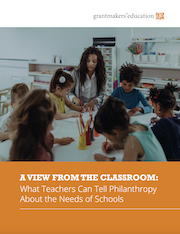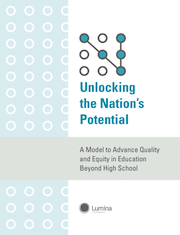Site Search
- resource provided by the Forum Network Knowledgebase.
Search Tip: Search with " " to find exact matches.
A corporate funder asked our corporate funder listserve about how the corporate foundation is funded either through an endowment or through periodic transfers, or though a share of the profits? This document is a compilation of the responses on the listserve.

What can over a million teachers tell us about the needs of schools? This report digs into the data from 1.8 million teacher requests on the crowdfunding site DonorsChoose to tell the story from inside today's classrooms. We feel this data provides a roadmap for funders seeking to support students directly, but also for funders seeking broader reform of U.S. education policy and systems.
What comes after “strategic...?” If you said, “planning,” you’re not alone. And for many leaders of community foundations, especially small ones who don’t have the time or money for a big process, anxiety is the feeling that follows. If that’s the case, this guide is for you.
It invites you to test-drive some activities to bring your current program, operations and community leadership strategies into focus before you decide whether to create a plan or not. It helps you discover ongoing strategic practices and decide whether to keep them or not. If you already have done a strategic plan, and it is languishing on a shelf, this guide will help you refresh it.
PART A: Good Strategy Takes Practice (Not Just Planning)
PART B: Do Your Discovery
PART C: Jumpstart Your Strategy Narrative
PART D: Bring It Together
Looking To What’s Next

Strategic asset allocation is arguably one of the most important, yet least advanced, aspects of investing. The Investment Strategy Group (ISG) in the Goldman Sachs Investment Management Division has developed a new approach to strategic asset allocation, which leverages the idea that long-term investment returns derive from multiple distinct sources called “return-generating factors.” This multi-factor approach is designed to help investors better understand the key sources of long-term return across asset classes and to increase the precision of long-term risk and return estimates. It also provides investors with a new way to think about portfolio diversification, allowing them to focus not only on diversification across asset classes but also
on diversification across the underlying sources of return.
The New Jersey Economic Development Authority (NJEDA) today announced that it anticipates awarding $14 million in grants to 27 organizations through its Sustain & Serve NJ program. The NJEDA launched applications for Sustain & Serve NJ in late 2020 to support restaurants that have been negatively impacted by the COVID-19 pandemic. The NJEDA expects that the funding announced today will result in the purchase of 1.5 million meals from at least 160 New Jersey restaurants in at least 69 cities in 12 counties.
“New Jersey’s restaurants were hit particularly hard by the COVID-19 pandemic, and the outpouring of interest in Sustain & Serve NJ underscores the community’s desire to help local restaurants and the neighborhoods they serve,” Governor Phil Murphy said. “The positive economic impact of this program for the restaurant industry, combined with the good it will do in the community, makes Sustain & Serve NJ a home run.”
Through Sustain & Serve NJ, the NJEDA anticipates providing $14 million in grant funding to entities throughout the Garden State to support expenses directly tied to bulk purchasing of meals from New Jersey-based restaurants. Each awardee will receive a grant of between $100,000 and $2 million to fund these purchases. The entities will then distribute the meals at no cost.
The New Jersey State Council on the Arts held its first public meeting of 2023 on February 28, where nearly $2 million was awarded to 140 New Jersey artists through the Council’s Individual Artist Fellowship program.
The Fellowships are competitive awards to New Jersey artists in 12 rotating disciplines granted solely on independent peer panel assessment of work samples. The anonymous process is focused on artistic quality, and awards may be used to help artists produce new work and advance their careers. New Jersey artists applied for awards this year in the categories of choreography, crafts, music composition, photography, playwriting/screenwriting, poetry, and sculpture. This program is carried out in partnership with Mid Atlantic Arts.
At the Council’s Annual Meeting last July, the Council voted to authorize an unprecedented investment of $2 million in the Individual Artist Fellowship program. Through that commitment of funding, this year’s Fellowship cohort is the largest one the Council has added to its distinguished list of Fellows in over 30 years. In order to further support the increased number of artists applying to the program, the Council developed a new level of awards in addition to the Fellowship Award. For the first time, the Council announced Finalist Awards. The Finalists Awards are given to those applicants who scored highly, but just below the cutoff to receive a Fellowship.
